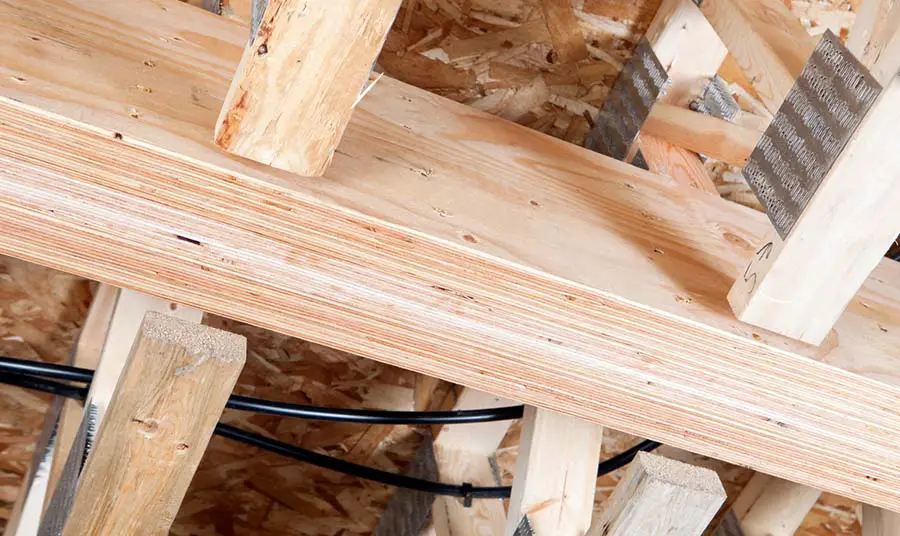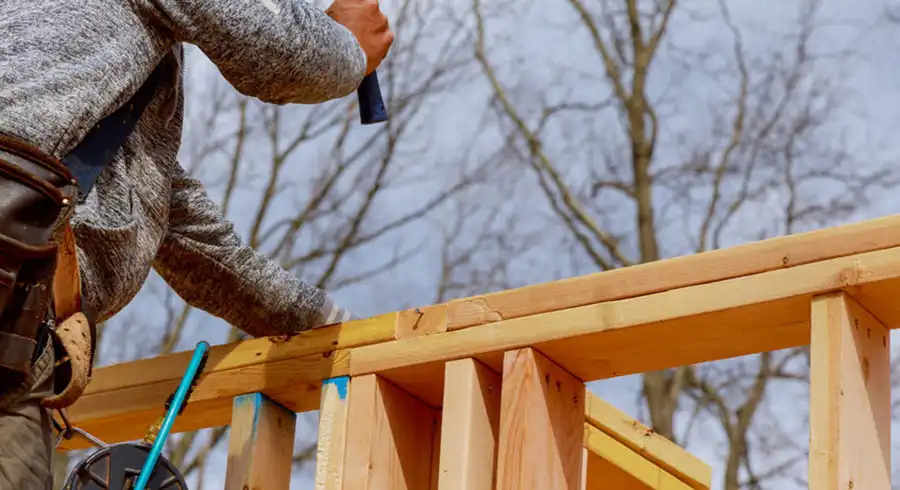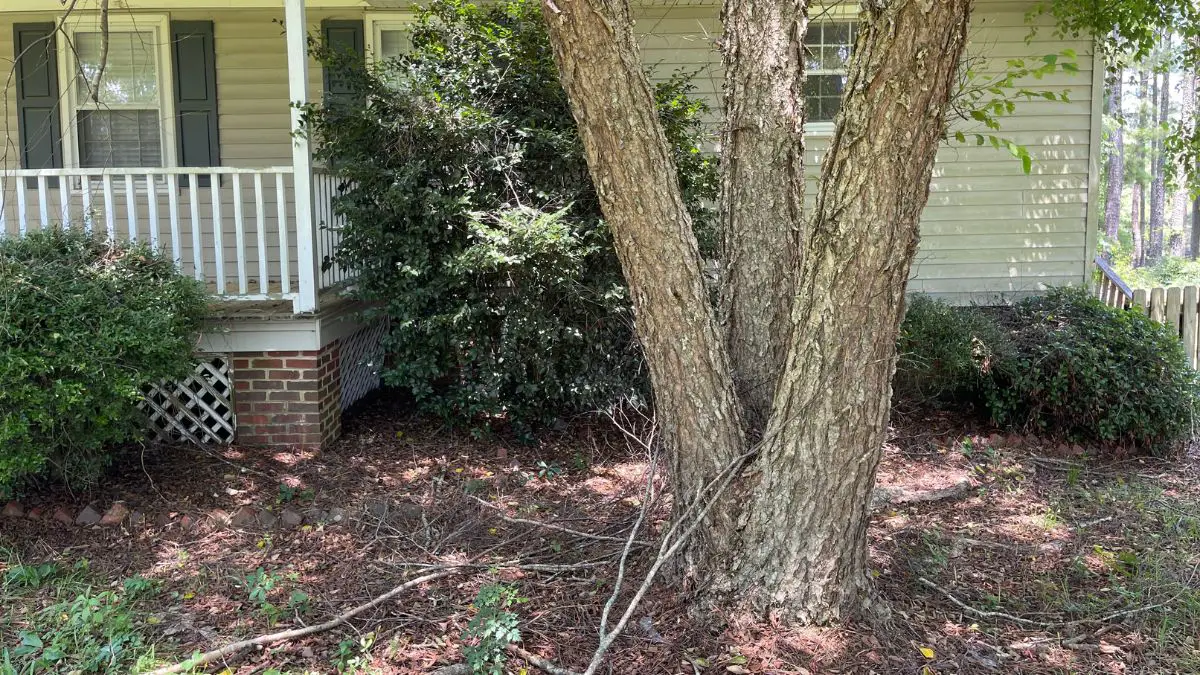
You might have a lot of experience as a carpenter, or you may not, but you have likely seen LVL wood products at some point. Contractors use Laminated Veneer Lumber (LVL) for beams, headers, studs, and more in today’s new home market. Although, you may be wondering how far an LVL beam can span.
Due to its strength, the LVL beam can span up to 60 feet and is much stronger than conventional lumber. Generally, you can find laminated beams in 4-foot increments starting at 24 feet and going up to 44 feet long, with special orders up to 60 feet. LVL beam thickness is usually between 1 ¾ and 7 inches.
Get FREE quotes from licensed building contractors in your area today. Whether you are remodeling or building a home or addition, We Can Help! All contractors are screened, licensed, and insured.
Questions about LVL engineered lumber, like what LVL stands for, how strong it is, and how you store it, are not always easy to find.
Here is a compiled list of the top questions about LVL wood all in one place. Combined with in-depth research and my decade-long experience as a home inspector, I gathered the answers.
What Does LVL Stand For?
LVL stands for Laminated Veneer Lumber and is similar to plywood in appearance. The difference is that plywood changes the grain’s direction with each layer, and LVL keeps the grain direction the same. LVL is typically made in a factory, straighter, more uniform, and stronger than traditional milled lumber. An LVL engineering process uses multiple layers of thin wood assembled with adhesives.
Engineered lumber was first seen in use as early as ancient Egypt. There is recorded use by the Chinese, English, French, and Russians well before the 20th century, and it received its first patent in 1856. During World War II, plywood became an essential war material.
The most common wood used in LVL beams is Douglas fir. Other woods are also used, such as:
- Yellow poplar
- Southern pine
- Other softwoods in the United States
The process to get to a finished LVL beam starts with debarking the log, then rotary peeling the veneer to send the sheets to the jet tube dryers to reduce the moisture content to 8-10%.
After drying, the manufacturer grades the veneer sheets, gets a resin application, and compresses the sheets until dry. They are cut to size, wrapped, and prepped for storage or transportation.
What is a Microlam LVL Beam?
Microlam is a common misspelling of Microllam, a Weyerhauser brand of engineered wood products. Microlam and Microllam refer to the same LVL product.
Weyerhauser referred to the product as “Microlam” for two years until then changed it to “Microllam.” Many still refer to Microlam when speaking of Microllam as they are frequently interchanged to identify all types of laminated veneer lumber.
Other manufacturers also make LVL engineered products, and all use similar processes for making engineered lumber.
Is LVL Stronger than Dimensional Lumber?
What are the Downsides of LVL Materials?
Are LVL Beams a Good Choice?
Do LVL Beams Sag?
A properly sized engineered LVL Beam will have some deflection by nature, but if properly built and installed with crowning up, the deflection makes the beam true and level. If you overspan any material, including LVL, you can experience sagging to an extent.
Always follow the manufacturer’s suggested span requirements, or consult a structural engineer when in doubt.
Most building codes have allowances for sag, and within those allowances, you will see LVL beams sag slightly at 14 feet and longer spans. This deflection or sag can be visible with an unleveled floor or even cracks in the drywall. This sag type is typical, especially in ten-year-old homes, and usually does not pose any safety issues.
How to Fasten LVL Beams Together?
Building LVL beams on the job site require specific fasteners to connect the layers making up the LVL beam. This type of LVL beam is commonly referred to as a Glulam beam.
When putting together sawn lumber, it is vital to find each board’s crown or direction of the bend. Finding the bend will help you match and put together the layers properly.
Once the crowns are marked and beams glued and layered together, you should use a structural wood screw connector. A few brands make a structural wood screw with a self-drilling point so it does not split the layers and a smooth shank to help squeeze the boards together for strength.
Manufacturers have specs to follow on faster placement and how many fasteners are needed when fastening the beams together.
Can You Notch an LVL Beam?
Although you can, most manufacturers do not recommend cutting or notching an LVL beam. Check with the LVL manufacturer; they should have technical specs on proper notching if approved.
It is recommended never to notch the tension side of the beam. Notching a beam on the tension side will reduce the strength of an LVL beam, according to Murphy Plywood. Notches cut perpendicular to grain can cause splitting along the length of the beam.
You can, however, drill holes in the beam at predetermined zones where horizontal holes are permitted for the passage of wires and conduits. You should not have vertical holes unless the beam width is 3 1/2 inches. Always consult an engineer or architect before cutting or drilling holes in an LVL beam.
How to Finish an LVL Beam
If a beam is cut, the cut end needs a coat of sealant to protect it from added moisture. LVL beams are engineered to be in a covered location and not exposed to the living area.
If you have an exposed LVL beam and want to finish it, you can always cover it with 1x cedar or pine to give it a natural look. When covering the beam with wood, a pro tip is to rip the bottom joints at 45 to provide the appearance of an actual beam.
You can use a combination of a power paint stripper and a rotary sander to remove the “factory” finish, commonly referred to as “waxy.” Using a primer before painting is critical on an LVL beam, and if you want to stain, you need to apply a lacquer sealer first to reduce the blotchiness. Solid stains work best.
It is good to keep any cut-offs to test paints or stains for coverage and appearance. If you don’t have any cut-off sections, ask the manufacturer for scrap to try.
Let’s not forget about finishing the beam with drywall. Using drywall is a standard wall covering and works well for hiding exposed beams. You should cover the beam simultaneously as the other drywall in the same room. The benefit of drywall is it will help hide the beam, so it is not as noticeable.
Should You Handle or Store LVL Beams Differently?

LVL beams are similar to traditional wood beams in that you should keep them wrapped to protect them from the weather and use stickers to separate bundles. To preserve the LVL beams from water damage, we recommend that you store the LVL material at least 12 inches off the ground.
If picking up with a crane, pick up the load using a spreader to minimize handling stress. It is also essential to avoid stacking other materials on top of LVL materials.
The wrapping on the LVL beams should be cut open from the bottom to release any excess moisture. If stored on the job site for more than a week, you’ll need an additional covering to protect the LVL beams from the weather. Monitor the condition of the beams and the coverings regularly during job site storage.
LVL or Glulam: Which is Better?
A Glulam differs from LVL in that it is sawn lumber glued together, whereas LVL is thin wood layers glued together. Both have considerable advantages over traditional sawn lumber. They are both strong and used in structural applications.
A Glulam beam also has a more excellent finish, adding to the visual appeal of the installation. LVL is manufactured longer and is more robust than Glulam.
Glulam is used in large structures and curved applications, including:
- Trusses
- Tied rafters
- Straight beams
- Curved beams
- Arched bridges
- Columns
LVL is used for structural applications in commercial and residential construction, including:
- Beams
- Truss chords
- Floor bearers
- Purlins
- Hip and valley rafters
- Lintels
- Studs
- Headers
Both Glulam and LVL have their place in modern construction, and one of the main reasons that builders choose LVL is that it’s much less expensive than Glulam. You can also fabricate LVL much thinner, which helps retrofit construction projects. They are both excellent choices for residential and commercial construction.
What is the Difference Between SCL and LVL?
Structural Composite Lumber (SCL) is a category of engineered wood products engineered by layering wood veneers, flakes, or strands with strong adhesives pressing it into lumber. LVL is in the SCL category with parallel strand lumber (PSL) and oriented strand lumber (OLS).
The term SCL meant all the products with layers glued together to form a highly predictable, precisely engineered product.
The SCL products’ Engineered wood has consistent sizes and is virtually free from splitting and warping. SCL wood is a top choice for builders of high-quality homes.
What is the Difference Between LSL and LVL?
Laminated Strand Lumber (LSL) is an engineered wood product made from strands of wood stacked, glued together, and then cut into lumber.
The advantage of using LSL to make beams is that it is very strong and stable. Laminated strand lumber beams are often used in construction projects where they are exposed to high loads or stresses, such as in the construction of bridges or tall buildings.
LSL and LVL lumber are the future of the home building industry as more wood timber is harvested from fast-growing softwood trees like pine, which as traditional lumber, would be prone to twisting.
Conclusion
Lvl is an excellent choice in lumber for quality home building due to its strength and straightness. LVL beams come up to 60 feet long and are stronger than traditional sawn lumber beams. It is relatively easy to produce, and a few manufacturers in the U.S. keep the price relatively low for engineered lumber.
LVL beams suit you if you are looking for the best bang for your buck. The added cost over traditional lumber is only slight compared to the straighter and easier to work with LVL beams.
Get FREE quotes from licensed building contractors in your area today. Whether you are remodeling or building a home or addition, We Can Help! All contractors are screened, licensed, and insured.








